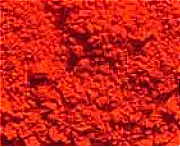| "Descrizione" by A_Partyns (12948 pt) | 2024-Apr-09 11:25 |
Review Consensus: 10 Rating: 10 Number of users: 1
| Evaluation | N. Experts | Evaluation | N. Experts |
|---|---|---|---|
| 1 | 6 | ||
| 2 | 7 | ||
| 3 | 8 | ||
| 4 | 9 | ||
| 5 | 10 |
FD & C Red No. 3 or CI 45430 or Erythrosine is a synthetic chemical dye coloured red with iodine. It is labelled with the number E127 in the list of European food additives.
The name describes the structure of the molecule.
- FD & C indicates that the color is approved by the United States Food and Drug Administration (FDA) for use in foods, drugs, and cosmetics. (1969, 1982)
- Red No. 3 refers to a particular red color, also known as Erythrosine, which is a synthetic dye.
- Description of raw materials used in production. Gallic acid and 3,4-dihydroxy benzaldehyde are the main raw materials used in the production of erythrosine. These substances are involved in the preparation of the xanthene component of the dye.
Step-by-step summary of industrial chemical process.
- Production of 3,4-Dihydroxy benzaldehyde. Gallic acid may be thermally treated to produce 3,4-dihydroxy benzaldehyde.
- Synthesis of Erythrosine. The 3,4-dihydroxy benzaldehyde is involved in the preparation of xanthene, which is subsequently converted into erythrosine through further synthetic steps.
- Purification. The crude erythrosine is purified through various processes, including crystallization, filtration, and chromatographic purification.
- Drying and Granulation. The purified dye is then dried and transformed into a stable solid form, which might be a powder or granules.
It appears in the form of a red powder.

Safety
Used in toothpastes and in food, it is considered safe for health if the maximum concentration does not exceed 0.0025% (25 ppm), however, different studies have found that this dye can create problems for human health (1).
It has an effect on the thyroid gland and is considered by the scientific literature to be a secondary tumorigenic agent (2).
Molecular Formula C20H6I4Na2O5 C20H6I4Na2O5H2O
Molecular Weight 879.86 g/mol
CAS 16423-68-0
Synonyms:
- Erythrosin B
- 2-(2,4,5,7-Tetraiodo-6-hydroxy-3-oxo-3H-xanthene-9-yl)benzoic acid
- Sodium 2',4',5',7'-tetraiodo-3-oxo-3H-spiro[isobenzofuran-1,9'-xanthene]-3',6'-bis(olate)
- 2',4',5',7'-Tetraiodofluorescein, disodium salt
- Disodium 2-(2,4,5,7-tetraiodo-6-oxido-3-oxoxanthen-9-yl)benzoate
- 9-(o-Carboxyphenyl)-6-hydroxy-2,4,5,7-tetraiodo-3H-xanthene-3-one disodium salt monohydrate
- Disodium 9-(O-carboxyphenyl)-6-hydroxy-2,4,5,7-tetraiodo-3H-xanthen-3-one monohydrate
- Disodium 3',6'-dihydroxy-2',4',5',7'-tetraiodospiro(isobenzofuran-1(3H),9'-(9H)xanthen)-3-one
- C.I.Solvent Red 140
- Erythrosinic acid
References_____________________________________________________________________
(1) Chequer FM, Venancio VP, Almeida MR, Aissa AF, Bianchi MLP, Antunes LM. Erythrosine B and quinoline yellow dyes regulate DNA repair gene expression in human HepG2 cells. Toxicol Ind Health. 2017 Oct;33(10):765-774. doi: 10.1177/0748233717715186.
Abstract. Erythrosine B (ErB) is a cherry pink food colorant and is widely used in foods, drugs, and cosmetics. Quinoline yellow (QY) is a chinophthalon derivative used in cosmetic compositions for application to the skin, lips, and/or body surface. Previously, ErB and QY synthetic dyes were found to induce DNA damage in HepG2 cells. The aim of this study was to investigate the molecular basis underlying the genotoxicity attributed to ErB and QY using the RT2 Profiler polymerase chain reaction array and by analyzing the expression profile of 84 genes involved in cell cycle arrest, apoptosis, and DNA repair in HepG2 cells. ErB (70 mg/L) significantly decreased the expression of two genes ( FEN1 and REV1) related to DNA base repair. One gene ( LIG1) was downregulated and 20 genes related to ATR/ATM signaling ( ATR, RBBP8, RAD1, CHEK1, CHEK2, TOPB1), nucleotide excision repair ( ERCC1, XPA), base excision repair ( FEN1, MBD4), mismatch repair ( MLH1, MSH3, TP73), double strand break repair ( BLM), other DNA repair genes ( BRIP1, FANCA, GADD45A, REV1), and apoptosis ( BAX, PPP1R15A) were significantly increased after treatment with QY (20 mg/L). In conclusion, our data suggest that the genotoxic mechanism of ErB and QY dyes involves the modulation of genes related to the DNA repair system and cell cycle.
(2) Poulsen E. Case study: erythrosine. Food Addit Contam. 1993 May-Jun;10(3):315-23. doi: 10.1080/02652039309374154.
Abstract. Erythrosine (FD & C Red No. 3) is an iodine-containing food colour which was used as an example in the application of the proposed approach of data-derived safety factors. The effect of erythrosine on the thyroid and the mechanism by which the effect is induced has been central to the discussion of the establishment of an Acceptable Daily Intake (ADI), or not, and a short account is given of the effect of erythrosine on the thyroid. The evaluation of erythrosine as a secondary tumorigenic agent was based on the evaluations of the Joint FAO/WHO Expert Committee on Food Additives (JECFA) and the Scientific Committee for Food of the Commission of the European Communities (SCF). In the proposed decision tree scheme, three different possibilities were examined. One was based on the long-term data and the second on the hormone data in the rat; the third was based on the NOEL for hormonal changes in humans. The three approaches with different NOEL and default values resulted in the following ADIs: 0.25, 0.3 and 0.1 mg/kg bw. The cases are discussed and it is concluded that the ADI based on the NOEL in human studies seems most appropriate. As there is most uncertainty about the default value for human pharmacokinetic variability, it is suggested that further human studies might elucidate this point.
| Evaluate |

